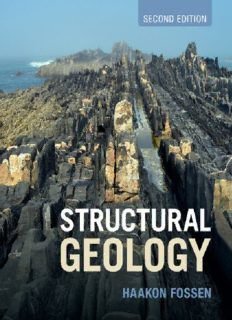
Structural Geology PDF
Preview Structural Geology
STRUCTURAL GEOLOGY SECOND EDITION THIS MARKET-LEADING TEXTBOOK HAS BEEN FULLY UPDATED IN RESPONSE TO EXTENSIVE USER FEEDBACK. IT INCLUDES A NEW CHAPTER ON JOINTS AND VEINS, ADDITIONAL EXAMPLES FROM AROUND THE WORLD, STUNNING NEW FIELD PHOTOS, AND EXTENDED ONLINE RESOURCES WITH NEW ANIMATIONS AND EXERCISES. THE BOOK’S PRACTICAL EMPHASIS, HUGELY POPULAR IN THE FIRST EDITION, FEATURES APPLICATIONS IN THE UPPER CRUST, INCLUDING PETROLEUM AND GROUNDWATER GEOLOGY, HIGHLIGHTING THE IMPORTANCE OF STRUCTURAL GEOLOGY IN EXPLORATION AND EXPLOITATION OF PETROLEUM AND WATER RESOURCES. CAREFULLY DESIGNED FULL-COLOR ILLUSTRATIONS WORK CLOSELY WITH THE TEXT TO SUPPORT STUDENT LEARNING, AND ARE SUPPLEMENTED WITH HIGH-QUALITY PHOTOS FROM AROUND THE WORLD. EXAMPLES AND PARALLELS DRAWN FROM PRACTICAL EVERYDAY SITUATIONS ENGAGE STUDENTS, AND END-OF-CHAPTER REVIEW QUESTIONS HELP THEM TO CHECK THEIR UNDERSTANDING. UPDATED E-LEARNING MODULES ARE AVAILABLE ONLINE FOR MOST CHAPTERS AND FURTHER REINFORCE KEY TOPICS USING SUMMARIES, INNOVATIVE ANIMATIONS TO BRING CONCEPTS TO LIFE, AND ADDITIONAL EXAMPLES AND FIGURES. Haakon Fossen is Professor of Structural Geology at the University of Bergen, Norway, where he is affiliated with the Department of Earth Science and the Natural History Collections. His professional career has involved work as an exploration and production geologist/geophysicist for Statoil and as a Professor at the University of Bergen (1996 to present), in addition to periods of geologic mapping and mineral exploration in Norway. His research ranges from hard to soft rocks and includes studies of folds, shear zones, formation and collapse of the Caledonian Orogen, numerical modeling of deformation (transpression), the evolution of the North Sea rift, and studies of deformed sandstones in the western United States. He has conducted extensive field work in various parts of the world, notably Norway, Utah/Colorado, and Sinai, and his research is based on field mapping, microscopy, physical and numerical modeling, geochronology and seismic interpretation. Professor Fossen has been involved in editing several international geology journals, has authored over 100 scientific publications, and has written two other books and several book chapters. He has taught undergraduate structural geology courses for twenty years and has a keen interest in developing electronic teaching resources to aid student visualization and understanding of geological structures. STRUCTURAL GEOLOGY Second Edition Haakon Fossen University of Bergen, Norway University Printing House, Cambridge CB2 8BS, United Kingdom Cambridge University Press is part of the University of Cambridge. It furthers the University’s mission by disseminating knowledge in the pursuit of education, learning and research at the highest international levels of excellence. www.cambridge.org Information on this title: www.cambridge.org/9781107057647 © Haakon Fossen 2016 This publication is in copyright. Subject to statutory exception and to the provisions of relevant collective licensing agreements, no reproduction of any part may take place without the written permission of Cambridge University Press. First published 2016 Printed in the United Kingdom by Clays, St Ives plc A catalogue record for this publication is available from the British Library ISBN 978-1-10705764-7 Hardback Additional resources for this publication at www.cambridge.org/fossen2e Cambridge University Press has no responsibility for the persistence or accuracy of URLs for external or third-party internet websites referred to in this publication, and does not guarantee that any content on such websites is, or will remain, accurate or appropriate. Contents How to use this book Preface Acknowledgments List of symbols 1 Structural geology and structural analysis 1.1 Approaching structural geology 1.2 Structural geology and tectonics 1.3 Structural data sets 1.4 Field data 1.5 Remote sensing and geodesy 1.6 DEM, GIS and Google Earth 1.7 Seismic data 1.8 Experimental data 1.9 Numerical modeling 1.10 Other data sources 1.11 Organizing the data 1.12 Structural analysis 1.13 Concluding remarks 2 Deformation 2.1 What is deformation? 2.2 Components of deformation 2.3 System of reference 2.4 Deformation: detached from history 2.5 Homogeneous and heterogeneous deformation 2.6 Mathematical description of deformation 2.7 One-dimensional strain 2.8 Strain in two dimensions 2.9 Three-dimensional strain 2.10 The strain ellipsoid 2.11 More about the strain ellipsoid 2.12 Volume change 2.13 Uniaxial strain (compaction) 2.14 Pure shear and coaxial deformations 2.15 Simple shear 2.16 Subsimple shear 2.17 Progressive deformation and flow parameters 2.18 Velocity field 2.19 Flow apophyses 2.20 Vorticity and W k 2.21 Steady-state deformation 2.22 Incremental deformation 2.23 Strain compatibility and boundary conditions 2.24 Deformation history from deformed rocks 2.25 Coaxiality and progressive simple shear 2.26 Progressive pure shear 2.27 Progressive subsimple shear 2.28 Simple and pure shear and their scale dependence 2.29 General three-dimensional deformation 2.30 Stress versus strain Summary 3 Strain in rocks 3.1 Why perform strain analysis? 3.2 Strain in one dimension 3.3 Strain in two dimensions 3.4 Strain in three dimensions Summary 4 Stress 4.1 Definitions, magnitudes and units 4.2 Stress on a surface 4.3 Stress at a point 4.4 Stress components 4.5 The stress tensor (matrix) 4.6 Deviatoric stress and mean stress 4.7 Mohr circle and diagram Summary 5 Stress in the lithosphere 5.1 Importance of stress measurements 5.2 Stress measurements 5.3 Reference states of stress 5.4 The thermal effect on horizontal stress 5.5 Residual stress 5.6 Tectonic stress 5.7 Global stress patterns 5.8 Differential stress, deviatoric stress and some implications Summary 6 Rheology 6.1 Rheology and continuum mechanics 6.2 Idealized conditions 6.3 Elastic materials 6.4 Plasticity and flow: permanent deformation 6.5 Combined models 6.6 Experiments 6.7 The role of temperature, water, etc. 6.8 Definition of plastic, ductile and brittle deformation 6.9 Rheology of the lithosphere Summary 7 Fracture and brittle deformation 7.1 Brittle deformation mechanisms 7.2 Types of fractures 7.3 Failure and fracture criteria 7.4 Microdefects and failure 7.5 Fracture termination and interaction 7.6 Reactivation and frictional sliding 7.7 Fluid pressure, effective stress and poroelasticity 7.8 Deformation bands and fractures in porous rocks Summary 8 Joints and veins 8.1 Definition and characteristics 8.2 Kinematics and stress 8.3 How, why and where joints form 8.4 Joint distributions 8.5 Growth and morphology of joints 8.6 Joint interaction and relative age 8.7 Joints, permeability and fluid flow 8.8 Veins
Description: